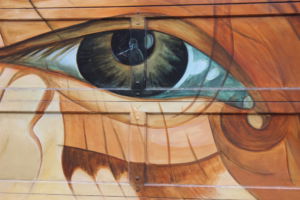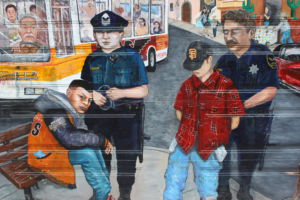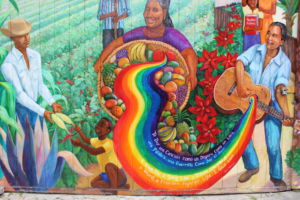Driving up to the Precita Eyes Mural Arts Center in San Francisco’s Mission District, visitors pass colorful mural after mural. However it is not until they begin the tour that they will begin to see the murals as so much more than just ordinary paintings. By viewing them up close and learning about their backgrounds, it becomes evident that these pieces are snapshots of the cruel reality many Latin Americans consistently face all over the world.
Precita Eyes, established in 1977, is a nonprofit organization that offers tours which feature local murals as a form of community education and expression. The organization hosts a tour that allows spectators to view the finished products, at an affordable price of $6 for teenagers.
Starting in Balmy Alley and stretching for six blocks, the tour goes at a relaxed pace, allowing guests to fully digest the works. The pieces depict the interests, history and struggles of Latin America. According to tour guide Patricia Rose, many murals feature Mexico and Central America, as about 60 percent of the area’s neighborhood originates from these regions.
Precita Eyes makes sure that only local, professional muralists conduct the tours in order to best inform the audience. This philosophy is evident, as Rose was one of the founders of the Mission District mural movement in 1971 and was able to answer almost any question by drawing from her own extensive experience.
However, there were some drawbacks of the tour. Although each painting is breathtaking, there were sporadic distractions of smelly garbage and noisy surroundings. This made it hard to hear Rose’s soft voice and led to a gradual decline in Rose’s energy as the tour continued.

Despite these setbacks of the tour, activists and historians will love the murals themselves. Many of the paintings address the issues that members of the Latino community commonly face such as barriers of immigrating to the U.S., the struggles for El Salvador and Nicaragua to heal from past civil wars, lack of drinkable water, pollution and racial profiling from the police and poverty.
Impressively, these paintings give rare perspectives on the issues by changing the subject’s viewpoint. For example, one mural demonstrated the tragedies of war reflected in a child’s eyes and another from the viewpoint of a guardian angel.

However in the early 1970s the Mission District was nowhere near becoming the mural hub it is today. Thanks to the hard work of Rose and her peers, artists from all over the world gathered to add onto the walls of Balmy Alley, making the Mission District a mural hub within only 15 years.
“Everyone has something to contribute. We do so many works as community participation projects that they become a personal record of our community’s struggle and achievements,” Rose said.
The creation of such works incorporates various parts of the local community, including families and youth organizations. The community members even gather to restore murals years later as the art ages.

The tour does not only discuss the paintings, but provides detail on artistic techniques behind each work: who painted it, where the artists originated and the reasons behind their message. This satisfies the interests of those with artistic backgrounds and pursuits.
However, not all the paintings depict life’s horrors, for some paid tribute to the activists who tried to stop them. Nevertheless, it would have been nice to have been shown more than just one or two of the more hopeful pieces.
In addition, various works paid tribute to religion, a common custom for many Latin Americans, by featuring famous icons such as the Virgin of Guadalupe and Oscar Romero, a pacifist priest from El Salvador who was brutally murdered in the Civil War. However, the tour did not take enough time to discuss such an important topic for many Latin Americans.
The company chooses different routes to take for every tour, so visitors will always be in for a surprise. Our selected path also revealed paintings that showed other influential figures in Latin American culture such as famous movie stars, female ancestors and popular singers. There was even an entire house that featured 104 singers not only from abroad, but from the district’s very own streets. This once again emphasizing that the community vibe made us feel at home.
Overall, touring the murals in San Francisco’s Mission District with Precita Eyes gives visitors a well-rounded experience. Despite setbacks and distractions, guests will move at an easy speed, which allows for time to absorb the murals’ information. Precita Eyes ensures that viewers will not only learn artistic techniques, but about various aspects of many Latin American lives.
–Contributions from Guest Writer, Sofia Melendez







